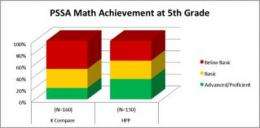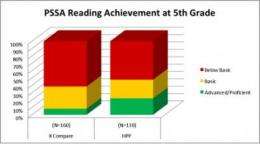Preschool program improves standardized test scores through grade 5

Continued participation in the Harrisburg Preschool Program (HPP) has led 5th-grade students to score higher on Pennsylvania System of School Assessment (PSSA) literacy and math tests than peers who have not participated in the HPP program, according to the final evaluation of the HPP initiative by the Prevention Research Center at Penn State.
HPP is a collaborative program involving the Harrisburg School District and Capital Area Head Start, which provides comprehensive, high-quality preschool services to at-risk children in the Harrisburg area.
"This evaluation has demonstrated substantial long-term effects of the HPP program on children's reading and math achievement," said Mark Greenberg, principal investigator of the evaluation and director of the Prevention Research Center for the Promotion of Human Development at Penn State. "The fact that this advantage has now been documented on the state's standardized achievement tests through 5th grade is additional evidence that preschool is critical for disadvantaged children, not only for their school readiness but for their longer-term achievement.
"The program was created as central components of former superintendent Dr. Gerald Kohn's plan to improve child development and academic outcomes."

According to the evaluation, in the 5th grade, the PSSA math scores for children who attended preschool had an average standardized score of 1243, while children in the comparison group had an average score of 1188. Thirty-five percent of HPP students were found to be advanced or proficient, while only 19 percent of non-attendees attained similar results. In all, the number of students advanced or proficient in mathematics increased by 50 percent.
A similar pattern emerged for reading scores. Children who attended preschool had an average score of 1133, while the comparison group had an average score of 1071. More students also were found to be advanced or proficient in reading achievement -- 22 percent among HPP attendees versus 8 percent among non-attendees, for a 175 percent increase. Both math and reading scores for children who attended the HPP program were significantly higher than those for children in the comparison group.
These findings indicate that enrollment in this preschool program is having significant long-term effects on children's learning outcomes.
"The HPP program has the important elements of high-quality preschool," Greenberg said. "This includes well-trained and well-equipped teachers; a vital and challenging curriculum in literacy, math and social emotional development; and a caring, supportive classroom environment that nurtures the learning of young children."
The HPP evaluation is directed by Greenberg and Celene Domitrovich, assistant director, Penn State Prevention Research Center, and supported by funding from the W.K. Kellogg Foundation. The evaluation of HPP ended in June 2011, when all students completed the 5th grade.
Provided by Pennsylvania State University
















